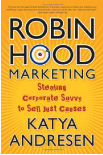You care passionately about something. You want other people to get involved. You want their time, money, ideas, commitment. How do you reach them? Do you send out mail? Work on your website? Go deep on Facebook, Twitter, Pinterest, Instagram? Sometimes it seems as if there’s a new way to reach out to people every day. How do you figure out what will really work for you?
 Stop. Take a deep breath. Now, read Katya Andresen’s Robin Hood Marketing: Stealing Corporate Savvy to Sell Just Causes.Andresen, until recently the chief operating officer and chief strategy officer of Network for Good, has been a journalist, a marketer, and a nonprofit executive. She doesn’t let the latest fad distract her. She gets right to the point. And the point is that good causes will not sell themselves–we have to use the most effective approaches to market them.Read the book for the “Robin Hood rules” she has robbed from the rich for-profit world and adapted for use by nonprofits. Chief among those rules are “focus on getting people to do something specific” and “appeal to your audience’s values, not your own.”
Stop. Take a deep breath. Now, read Katya Andresen’s Robin Hood Marketing: Stealing Corporate Savvy to Sell Just Causes.Andresen, until recently the chief operating officer and chief strategy officer of Network for Good, has been a journalist, a marketer, and a nonprofit executive. She doesn’t let the latest fad distract her. She gets right to the point. And the point is that good causes will not sell themselves–we have to use the most effective approaches to market them.Read the book for the “Robin Hood rules” she has robbed from the rich for-profit world and adapted for use by nonprofits. Chief among those rules are “focus on getting people to do something specific” and “appeal to your audience’s values, not your own.”
- What can we ask people to do that will be “fun, easy, popular, and rewarding”? (for supporters)
- “Who wins when we win?” (for partners)
- How can we supply information that is expert, fast, first, accurate, and tells a good story? (for journalists–they are a target audience too!)
I cannot give you a good enough sense of how rich this book is in a review. It is so chock-full of detailed suggestions and examples that the best summary of the book is reading the book itself. And it is very well organized, with bullet points up front, highlights marked throughout, and interviews at the end of each chapter. I read the first edition of the book, originally published in 2006, and it still feels timely and up to date. That’s what comes of focusing on the relationship between the organization and the audience and not on the constantly changing media.
My one reservation about this book is the same one that’s been coming up in my mind as I read a lot of books about communications, marketing, or psychology lately–even books I really like, such as the Heath brothers’ Switch and Made to Stick, and Beth Kanter and Allison Fine’s The Networked Nonprofit. These books offer great ideas on how to change an individual’s behavior, or even a lot of individuals’ behavior. But that is not the same thing as social change.
Social change generally means going up against entrenched structures of power. Reading these books, you would never imagine that capitalism, racism, sexism, and tightly defined norms around gender affected anybody’s lives. You would think that getting people to smoke less, use condoms, eat healthier diets, and donate to good organizations would revolutionize the way we live.
Perhaps it’s just that social change is outside the scope of these books. But the authors market the books as if social change would come from better communications strategies alone. That’s selling their books too hard. They are worthwhile to read on their own merits. People working for just causes need and should take advantage of the savvy that Katya Andresen supplies.
